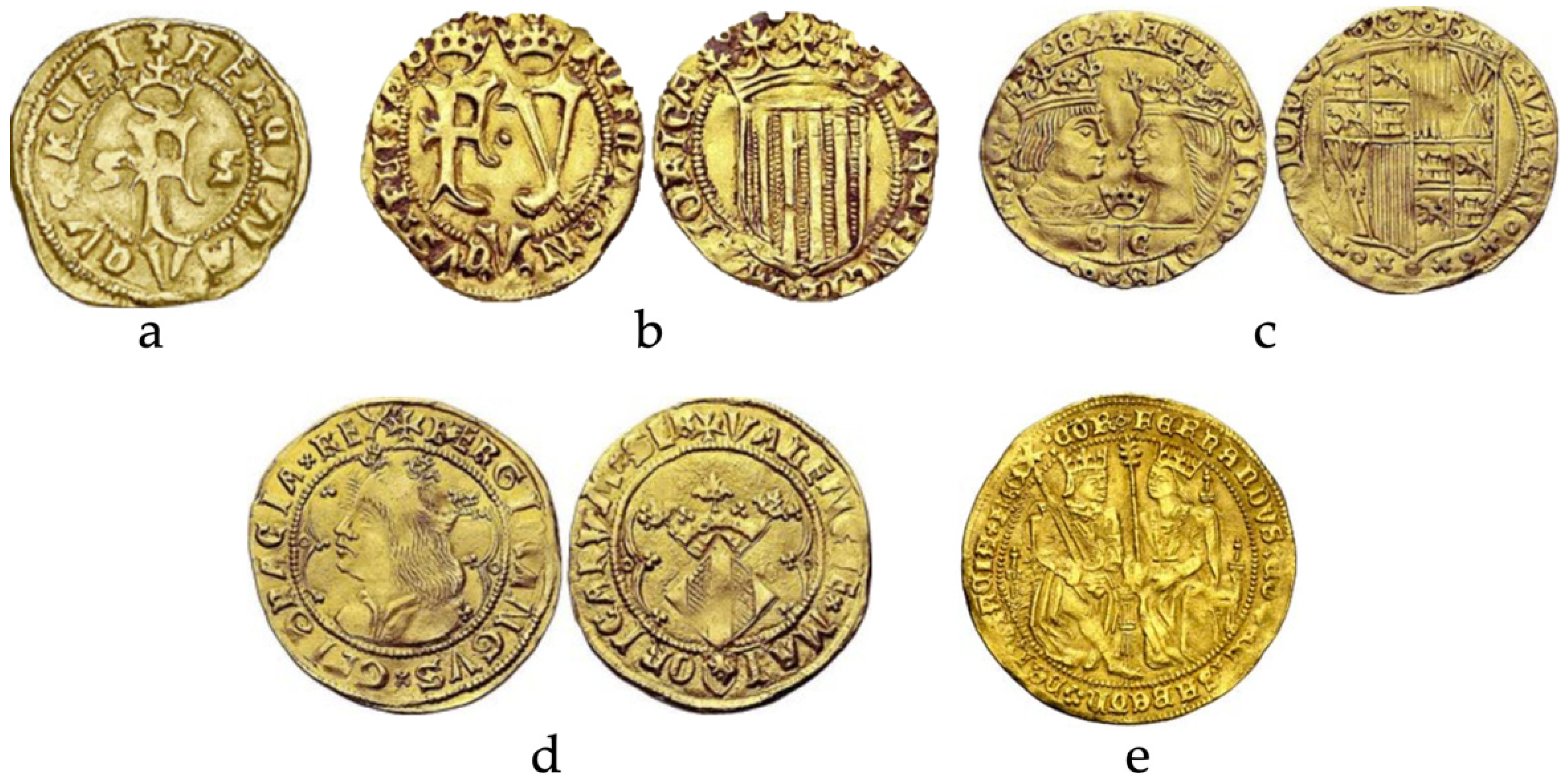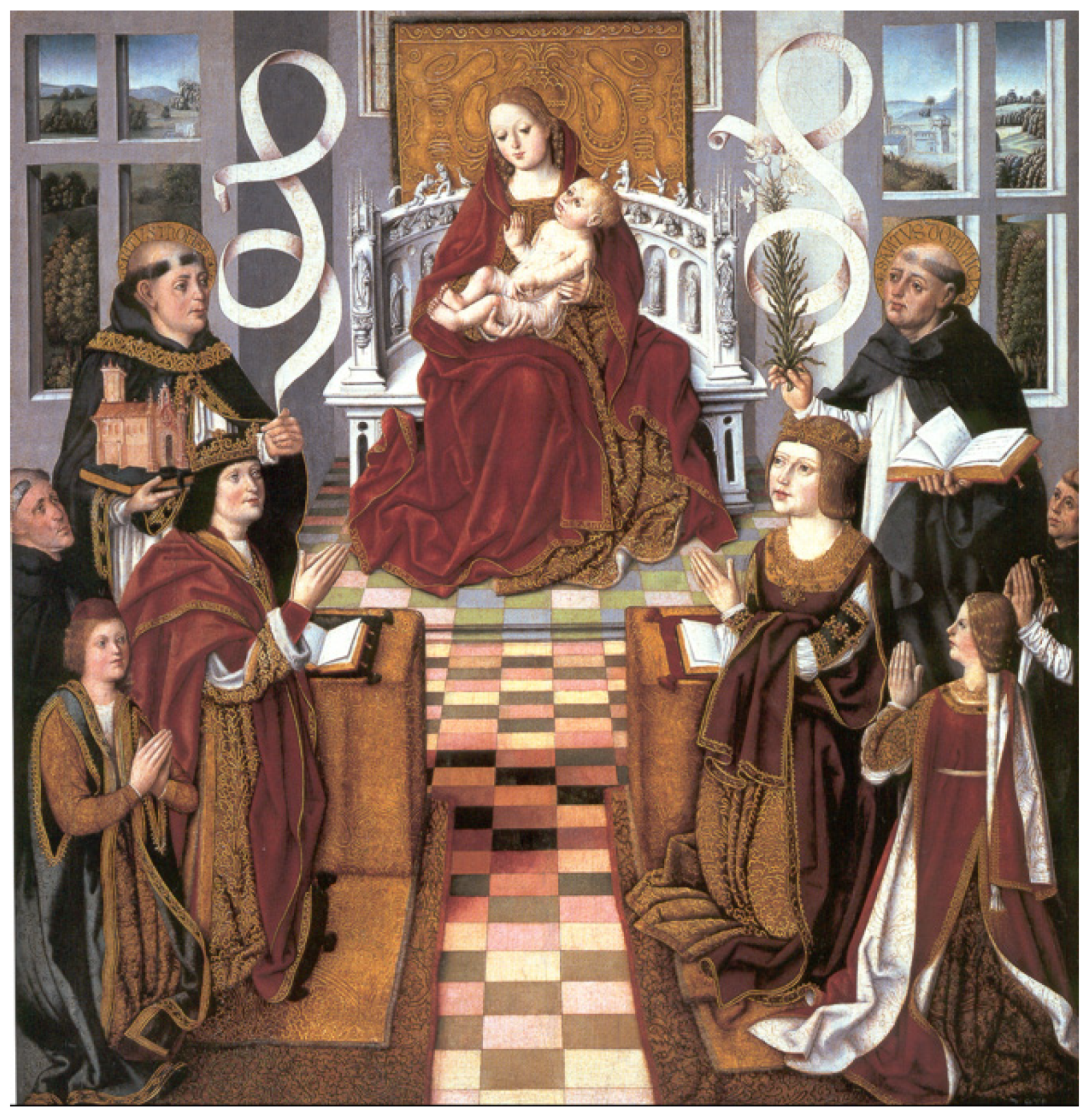Ferdinand II of Aragon (1479–1516)
Definition
:1. Introduction to the Reign of Ferdinand II
2. Character, Appearance and Artistic Patronage
3. Elements of a Legal Nature: Coins and Seals
3.1. Coins
3.2. Seals
4. Instrumental Character of Art
4.1. Government Images
4.2. The King as Caput Milicie
4.3. Devotional Images
5. A New Artistic Genre at Court: Portraiture
6. Conclusions
Funding
Conflicts of Interest
Entry Link on the Encyclopedia Platform
References
- Solano, F. Fernando el Católico y el Ocaso del Reino Aragonés; Universidad de Zaragoza: Zaragoza, Spain, 1979. [Google Scholar]
- Redondo, G.; Orera, L. Fernando II y el Reino de Aragón; Guara: Zaragoza, Spain, 1980. [Google Scholar]
- Sarasa, E. Aragón en el Reinado de Fernando I (1412–1416); Institución Fernando el Católico: Zaragoza, Spain, 1986. [Google Scholar]
- Sesma, J.A. Fernando de Aragón. Hispaniarum Rex; Gobierno de Aragón: Zaragoza, Spain, 1992. [Google Scholar]
- Belenguer, E. Ferran II. El rei del Redreç? Institut d’Estudis Catalans: Barcelona, Spain, 2017. [Google Scholar]
- Salicrú, R. De Martí I l’Humà, del Compromís de Casp o de Ferran I a Ferran II: La Catalunya del segle XV, un segle de canvis i transicions. In El segle XV, Temps de Canvis i Incerteses; Arxiu de Vilassar de Dalt: Vilassar de Dalt, Spain, 2017; pp. 17–36. [Google Scholar]
- Pulgar, H. Crónica de Los Reyes Católicos; Biblioteca de Autores Españoles: Madrid, Spain, 1953; tom. LXX, cap. III, 2nd part; p. 255. [Google Scholar]
- Yarza, J. Los Reyes Católicos. Paisaje Artístico de una Monarquía; Nerea: Madrid, Spain, 1993; pp. 114–121. [Google Scholar]
- Dietaris de la Generalitat de Catalunya, 1411–1714; Sans, J.M. (Dir.) (Ed.) Generalitat de Catalunya: Barcelona, Spain, 2000. [Google Scholar]
- Duran, A. Barcelona i la Seva Història; Curial: Barcelona, Spain, 1975; Volume II, p. 133. [Google Scholar]
- Serrano, M. Ferdinandus Rei Gracia Rex Aragonum. La efigie de Fernando II el Católico en la Iconografía Medieval; Institución Fernando el Católico: Zaragoza, Spain, 2014; pp. 51–54. [Google Scholar]
- Andrew, E. The foxy prophet: Machiavelli versus Machiavelli on Ferdinand the Catholic. Hist. Political Thought 1990, 11, 409–422. [Google Scholar]
- Yarza, J. Gusto y promotor en la época de los Reyes Católicos. Ephialte 1992, III, 21–70. [Google Scholar]
- Yarza, J. Imágenes reales hispanas en el fin de la Edad Media. In Poderes Públicos en la Europa Medieval: Principados, Reinos y Coronas; Gobierno de Navarra: Pamplona, Spain, 1997; pp. 441–500. [Google Scholar]
- Yarza, J. Entre Flandes e Italia. Dos modelos y su adopción en la España de los Reyes Católicos. In Los Reyes Católicos y la Monarquía de España; Generalitat de València: Valencia, Spain, 2001; pp. 313–327. [Google Scholar]
- Yarza, J. Política artística de Fernando el Católico. In De la Unión de Coronas al Imperio de Carlos V; Belenguer, E., Ed.; Sociedad Estatal para la conmemoración de los centenarios de Felipe II y Carlos V: Madrid, Spain, 2001; pp. 15–29. [Google Scholar]
- Yarza, J. La Nobleza Ante el Rey. Los Grandes Linajes Castellanos y el Arte del Siglo XV; Viso: Madrid, Spain, 2003. [Google Scholar]
- Crusafont, M. Numismática de la Corona Catalano-Aragonesa Medieval (785–1516); Vico: Madrid, Spain, 1982; p. 137. [Google Scholar]
- Campo, M. (coom.). La Imatge del Poder a la Moneda; Museu Nacional d’Art de Catalunya: Barcelona, Spain, 1998; p. 23. [Google Scholar]
- Álvarez-Ossorio, F. Catálogo de las Medallas de los Siglos XV y XVI; Cuerpo Facultativo de Archiveros, Bibliotecarios y Arqueólogos: Madrid, Spain, 1950; pp. 377–384. [Google Scholar]
- Crusafont, M. Acuñaciones de la Corona Catalano-Aragonesa y de los Reinos de Aragón y Navarra. Medioevo y Tránsito a la Edad Moderna; Vico: Barcelona, Spain, 1992; pp. 68–69. [Google Scholar]
- Mateu, F. La Iconografía Sigilográfica y Monetaria de los Reyes Católicos; Anales y Boletín de los Museos de Arte: Barcelona, Spain, 1944; p. 16. [Google Scholar]
- Murray, G. La moneda durante el reinado de Isabel la Católica. In Isabel, Reina de Castilla; Caja de Segovia: Segovia, Spain, 2004; pp. 243–264. [Google Scholar]
- Alfaro, C. La reforma de la moneda. In Los Reyes Católicos y la Monarquía de España; Generalitat de València: Valencia, Spain, 2001; pp. 97–104. [Google Scholar]
- Balaguer, A.M.; García, M.; Crusafont, M. Historia de la Moneda Catalana; Caja de Barcelona: Barcelona, Spain, 1986; p. 73. [Google Scholar]
- Sanz, C. Las primeras acuñaciones de los Reyes Católicos. Rev. Arch. Bibl. Mus. 1920, XLI, 71. [Google Scholar]
- Balaguer, A.M. La moneda y su historia en el reinado de los Reyes Católicos. Numisma 1993, 233, 138. [Google Scholar]
- Gallego, P. Dineral inédito. Numisma 1996, 238, 238. [Google Scholar]
- De Sagarra, F. Sigil·Lografia Catalana. Inventari, Descripció i Estudi Dels Segells de Catalunya; Estampa d’Henrich: Barcelona, Spain, 1916–1932; p. 109. [Google Scholar]
- Carriazo, J. Los Relieves de la Guerra de Granada en la Sillería del Coro de la Catedral de Toledo; Universidad de Granada: Granada, Spain, 1985. [Google Scholar]
- Checa, F. Poder y piedad: Patronos y mecenas en la introducción del Renacimiento en España. In Reyes y Mecenas. Los Reyes Católicos-Maximiliano I y los Inicios de la Casa de Austria en España; Ministerio de Cultura: Toledo, Spain, 1992; p. 30. [Google Scholar]
- Pereda, F. Los relieves toledanos de la guerra de Granada: Reflexiones sobre el procedimiento narrativo y sus fuentes clásicas. In Correspondencia e Integración de las Artes; Coloma, I., Sánchez, J.A., Eds.; Ministerio de Educación, Cultura y Deporte: Málaga, Spain, 2003; p. 345. [Google Scholar]
- Arena, H. Las sillerías de coro del maestro Rodrigo Alemán. Bol. Semin. Arte Arqueol. 1966, XXXII 1, 95. [Google Scholar]
- Mogollón, P.; Pizarro, F.J. La sillería de coro de la Catedral de Plasencia; Universidad de Extremadura: Salamanca-Soria, Spain, 1992; p. 11. [Google Scholar]
- Teijeira, M.D. Estalos de los Reyes Católicos. In Maravillas de la España Medieval. Tesoro Sagrado y Monarquía; Bango, I., Ed.; Caja España: León, Spain, 2000; p. 366. [Google Scholar]
- Checa, F. Fernando el Católico. Isabel la Católica. In Reyes y Mecenas. Los Reyes Católicos-Maximiliano I y los Inicios de la Casa de Austria en España; Ministerio de Cultura: Toledo, Spain, 1992; p. 426. [Google Scholar]
- Galiay, J. Retrato de los Reyes Católicos en la portada de la Iglesia de Santa Engracia de Zaragoza. Semin. Arte Aragones 1945, 1, 7–14. [Google Scholar]
- Morte, C. Fernando el Católico y las artes. In Las Artes en Aragón Durante el Reinado de Fernando el Católico 1479–1516; Institución Fernando el Católico: Zaragoza, Spain, 1993; p. 162. [Google Scholar]
- Ibáñez, J. La portada de Santa Engracia. In Santa Engracia. Nuevas Aportaciones para la Historia del Monasterio y Basílica; Gobierno de Aragón: Zaragoza, Spain, 2002; pp. 179–207. [Google Scholar]
- Sigüenza, J. Historia de la Orden de San Jerónimo; Bailly-Bailliere: Madrid, Spain, 1909; Volume II, p. 52. [Google Scholar]
- Morte, C. Patrocinio artístico de los reyes y de la nobleza en Aragón a finales del Gótico y durante el Renacimiento. In Actes del I, II i III Col·loquis sobre Art i Cultura a l’època del Renaixement a la Corona d’Aragó; Ajuntament de Tortosa: Tortosa, Spain, 2000; p. 150, n. 7. [Google Scholar]
- Morte, C. La iconografía real. In Fernando II de Aragón. el Rey Católico; Institución Fernando el Católico: Zaragoza, Spain, 1996; p. 54. [Google Scholar]
- Esteban, J.F. Museo colegial de Daroca; Ministerio de Educación y Ciencia: Madrid, Spain, 1975; pp. 36–37. [Google Scholar]
- Lacarra, C. Conjunto de tablas con el milagro de los Sagrados Corporales. In El espejo de Nuestra historia. La diócesis de Zaragoza a Través de los Siglos; Arzobispado y Ayuntamiento de Zaragoza: Zaragoza, Spain, 1991; p. 450. [Google Scholar]
- Sorroche, M.A. Anónimo, Escuela hispanoflamenca. Piedad con los santos Juanes y los Reyes Católicos. In Los Reyes Católicos y la Monarquía de España; Generalitat de València: Valencia, Spain, 2001; p. 359. [Google Scholar]
- Silva, M.P. Pintura hispanoflamenca: Burgos y Palencia. Obras en Tabla y Sarga; Junta de Castilla y León: Valladolid, Spain, 1990; Volume II, p. 400. [Google Scholar]
- Yarza, J. Un arte al servicio de los reyes. In Isabel I, Reina de Castilla; Caja de Segovia, Obra Social y Cultural: Segovia, Spain, 2004; p. 147. [Google Scholar]
- Carderera, V. Iconografía Española. Colección de Retratos, Estatuas, Mausoleos y Demás Monumentos Inéditos de Reyes, Reinas, grandes Capitanes, Escritores, etc. Desde el Siglo XI Hasta el XVII; Ramón Campuzano: Madrid, Spain, 1855–1864; planche LVII. [Google Scholar]
- Yarza, J. El retrato medieval: La presencia del donante. In El Retrato en el Museo del Prado; Anaya: Madrid, Spain, 1994; pp. 90–92. [Google Scholar]
- Angulo, D. Isabel la Católica, sus Retratos, sus Vestidos, sus Joyas; Universidad Menéndez Pelayo: Santander, Spain, 1951; p. 46. [Google Scholar]
- Frieländer, M.J. Neus über den Meister Michiel und Juan de Flandes. Cicerone 1929, 21, 249. [Google Scholar]
- Sesma, A. Tablas procedentes del políptico de Isabel la Católica 1496–1504. In Reyes y Mecenas. Los Reyes Católicos-Maximiliano I y los Inicios de la Casa de Austria en España; Ministerio de Cultura: Toledo, Spain, 1992; pp. 465–468. [Google Scholar]
- Cela, M.E. Elementos Simbólicos en el arte Castellano de los Reyes Católicos; Universidad Complutense: Madrid, Spain, 1991; pp. 482–520. [Google Scholar]
- Gudiol, J. La Pintura Mig-Eval Catalana; Babra: Barcelona, Spain, 1927; Volume II, p. 19. [Google Scholar]
- Angulo, D. Un nuevo retrato de Isabel la Católica. Archivo Hispalense. Revista Histórica, Literaria y Artística 1951, 14, 333–335. [Google Scholar]
- Schütz, K. Retrato del rey Fernando el Católico de Aragón. In Reyes y Mecenas. Los Reyes Católicos-Maximiliano I y los Inicios de la Casa de Austria en España; Ministerio de Cultura: Toledo, Spain, 1992; p. 419. [Google Scholar]
- Fernández, I. Anónimo. Fernando el Católico. In Los Reyes Católicos y la Monarquía de España; Generalitat de València: Valencia, Spain, 2001; p. 372. [Google Scholar]






Publisher’s Note: MDPI stays neutral with regard to jurisdictional claims in published maps and institutional affiliations. |
© 2021 by the author. Licensee MDPI, Basel, Switzerland. This article is an open access article distributed under the terms and conditions of the Creative Commons Attribution (CC BY) license (https://creativecommons.org/licenses/by/4.0/).
Share and Cite
Serrano-Coll, M. Ferdinand II of Aragon (1479–1516). Encyclopedia 2021, 1, 1182-1191. https://doi.org/10.3390/encyclopedia1040089
Serrano-Coll M. Ferdinand II of Aragon (1479–1516). Encyclopedia. 2021; 1(4):1182-1191. https://doi.org/10.3390/encyclopedia1040089
Chicago/Turabian StyleSerrano-Coll, Marta. 2021. "Ferdinand II of Aragon (1479–1516)" Encyclopedia 1, no. 4: 1182-1191. https://doi.org/10.3390/encyclopedia1040089
APA StyleSerrano-Coll, M. (2021). Ferdinand II of Aragon (1479–1516). Encyclopedia, 1(4), 1182-1191. https://doi.org/10.3390/encyclopedia1040089





